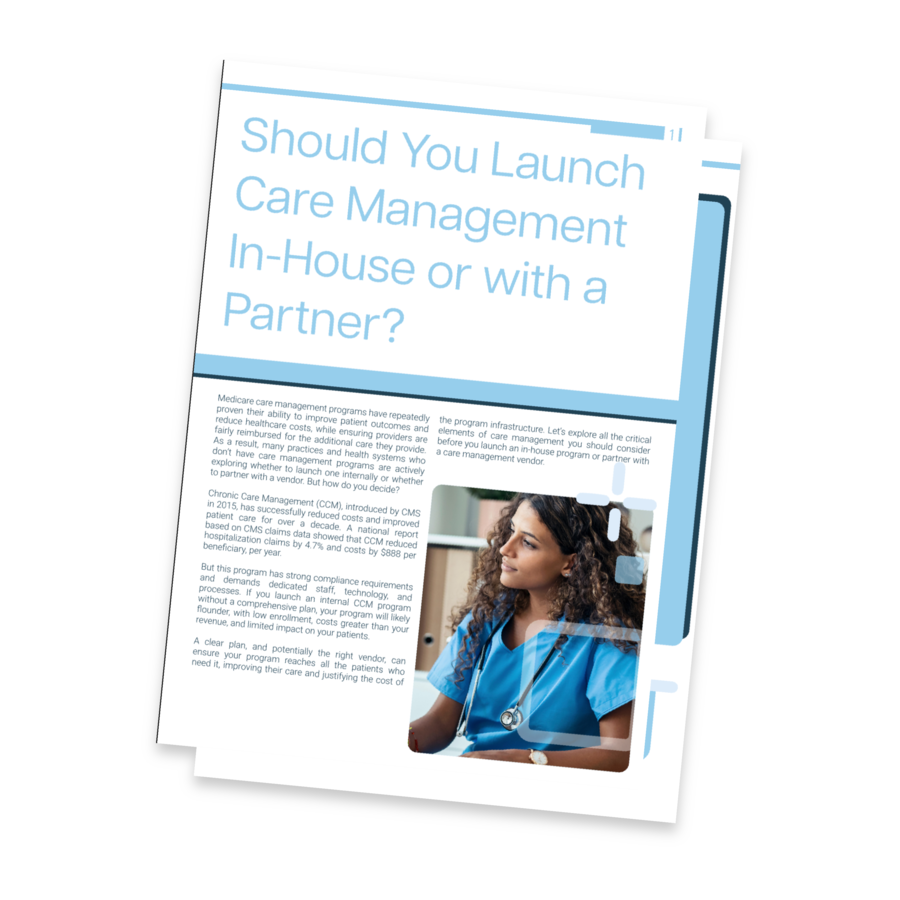
Talk with a ChartSpan Representative Today!
Our team is ready to help you improve patient care and outcomes.
Blog
Healthcare Technology for Chronic Care Management: Benefits & Advancements
The Chronic Care Management (CCM) model hinges on the idea that supplemental support, beyond and between traditional doctors’ visits, can help patients with chronic disease achieve a better quality of life, reduce complications, and successfully manage symptoms.
Implementing a CCM program, however, is a significant undertaking. Many practices lack the internal resources to support the multifaceted, around-the-clock services CCM requires.
Technology answers this dilemma, bringing CCM within reach for patients and providers. At the same time, healthcare technology expands Chronic Care Management support, extending access to underserved and rural populations.
Working with a tech-enabled CCM partner allows providers to elevate their care with technology. That’s true even for healthcare teams without the capacity to implement their own CCM programs. Partnership with a CCM provider extends the benefits of technology to such practices and their patients.
From integrations with electronic health record (EHR) platforms to artificial intelligence, the latest technology advancements have the potential to facilitate better health for more patients.
We’ll explore how healthcare technology is reshaping Chronic Care Management for providers and patients and share how ChartSpan can help you leverage these benefits toward better care.
The role of healthcare technology in CCM
There are numerous applications for healthcare technology in CCM, from improving connectivity and convenience to boosting accuracy and outcomes.
Telephonic software and live texting, for example, can help CCM programs achieve better results for patients by closing gaps in communication and creating opportunities for more timely, responsive care. This is particularly true for rural and older individuals who may find it difficult to travel to the provider’s office and who benefit from easy contact methods.
Other innovations like reporting and analytics software improve care coordination, allowing multiple providers to track and collaborate on patient progress. Still other healthcare advancements play a critical role in helping you and your patients overcome Social Determinants of Health (SDOH) challenges, such as lack of transportation or other non-medical factors that affect health outcomes.
Healthcare technology can also facilitate continuity of care. Cloud data sharing and EHRs are two technologies that enhance specificity and accuracy in treatment, giving providers and care managers easy access to the right information on patients’ medical history and care plans.
Despite the promise these solutions hold for Chronic Care Management, harnessing emerging technology in healthcare can be challenging for individual practices. Working with a CCM partner reduces the burden on your team and enables your practice to realize the benefits of the latest Chronic Care Management technology.
9 healthcare technologies for CCM
1. Cloud data sharing
In the context of Chronic Care Management, cloud data sharing refers to the practice of storing patient information in a secure cloud-based platform. This healthcare technology improves continuity of care by centralizing important patient health data and communication so providers can collaborate seamlessly.
Cloud data sharing also facilitates real-time updates, meaning you can make informed care decisions based on up-to-date patient information. Choosing a HIPAA-compliant solution is essential to complying with regulations and protecting sensitive personal health information.
2. Electronic health records (EHR)
Electronic health records (EHR) serve as a single source of truth for a patient’s entire medical history. Leveraged properly, they can provide a complete picture of patient health across various healthcare systems, providers, and visits. For CCM programs, an EHR offers a historical record of a patient’s chronic conditions, allowing you to document changes and improvements over time.
An EHR also supports patient self-management of chronic conditions, enabling patients to become active participants in their own healthcare. By providing access to visit notes and lab results and improving communication with providers, EHRs give patients the tools and information they need to achieve progress between formal instances of care.
CCM programs and software should integrate with your EHR system to avoid information silos and gaps in patients’ medical history. ChartSpan’s HIPAA-compliant CCM software integrates directly with popular EHR platforms to facilitate the seamless flow of information.
3. Artificial Intelligence (AI)
Some CCM software providers deploy AI to improve the quality of chronic disease management. We offer a HIPAA-compliant AI tool that screens 100% of patient calls for quality, documentation, and compliance with CMS requirements. The resulting data informs improvements that can boost patient experience and quality of care.
AI is also transforming Chronic Care Management by providing new ways to analyze data and address patient needs with greater precision. AI predictive modeling, for example, can flag patient vital signs, SDOH challenges, and other health indicators that put patients at risk of complications. Tools like these help spot problems before they occur for a proactive and cost-effective treatment approach. Generative AI can also support patient self-management by crafting achievable care goals or compiling patient education materials tailored to specific individuals.
4. Telephonic software
Phone technologies bridge the gap between face-to-face care and the day-to-day management of chronic disease. By providing an easy avenue for communication, telephonic software surfaces issues quickly and facilitates proactive intervention.
Additionally, telephonic software illustrates the importance of technology in healthcare by improving access to care. No matter where they are, patients can always connect with the care they need. Telephonic tools mean timely support doesn’t require a formal patient visit.
Advanced vendors like ChartSpan offer additional features. Our software, for example, utilizes autodialers. This saves operators time and hassle, making reaching patients easy. The system also customizes outbound phone numbers to fit the appropriate area code for the patient to maximize the chances of connection.
At the same time, telephonic software can reduce patient no-show rates with appointment reminder calls and text reminders. In turn, this sort of contact can improve patient engagement and empower patients to take ownership of their health.
Although 24/7 access to care is a CCM requirement, many practices find this constant availability difficult to maintain. That’s one reason partnering with a CCM provider can help. Our 24/7 phone and text line provides access to our clinical team, ensuring patients have uninterrupted support for adhering to their comprehensive care plans.
5. Time-tracking tools
Accuracy is important in healthcare, and technology plays a key role in achieving it. Time-tracking tools, like the ones embedded in our CCM software, help teams establish an accurate record of time spent with patients. That data then informs precise billing and patient monitoring.
Time-tracking software is particularly important in CCM, where insufficient patient support can result in suboptimal patient outcomes and compliance issues. Time-tracking tools also help CCM providers identify which patients require more frequent care so that they can allocate resources efficiently.
6. Reporting software
Required reporting for CCM should feel effortless with the right reporting software. To that end, our documentation software includes a proprietary technology that allows the provider to oversee a successful program.
From managing and approving patient enrollment status to monitoring financial outlook and more, all the project management tools a manager needs are easily accessible within the software.
Reporting tools also make it easier for providers to spot trends in patient health data and intervene when necessary. By surfacing key health trends, documentation tools enhance care coordination. Likewise, these tools help clinicians monitor the effectiveness of treatment and make adjustments as needed.
This ability to keep patients in the loop on their health trajectory makes reporting software especially crucial for CCM programs. The transparency of reporting tools empowers patient self-management. Patients gain the data they need to assume responsibility for their health outcomes.
7. Analytics tools
For patients and providers, analytics tools go one step further than reporting software, interpreting the reported data and guiding patients and providers toward optimized care. Analytics tools can also highlight gaps in care or even provide treatment recommendations, all of which support positive patient outcomes.
By helping clinical teams make sense of patient data, analytics tools can reduce costs, improve decision-making, and identify patients likely to suffer complications. Used in conjunction with other technologies, like phone software and AI, this healthcare technology holds enormous promise to help patients achieve better health.
8. Live texting
Live texting offers another avenue for patient-provider communication. In the context of CCM, live texting can improve medication adherence with timely reminders or give patients another way to contact care managers with health questions. Leveraging live texting can be a strategic choice for providers, since it offers even more convenience for patients and gives them an easy channel to report issues or seek help.
ChartSpan’s two-way, quick-response live texting feature gives patients a direct line to their care teams. Along with our 24/7 phone line, texting technology makes it possible for our partner providers to offer constant support at any hour, in accordance with CMS requirements.
9. Remote care
Technology has already changed the way patients receive care. Convenient and accessible, remote care options help overcome some of the challenges many patients face when seeking care, like time, transportation, or mobility issues.
For CCM programs, remote care services provide additional healthcare access. This healthcare technology could also allow patients to connect with care managers 24 hours a day via text or phone.
Though telehealth is distinct from Chronic Care Management, it also offers opportunities for remote care. For example, telehealth can give patients access to specialists they couldn’t consult otherwise, due to location or transportation limitations.
Some chronic conditions, like asthma and hypertension, are particularly well-suited to remote care, since they require constant supervision and regular check-ins. When used in conjunction with other technologies, remote care helps you gain a sufficient understanding of a patient’s health anytime and anywhere.
Benefits of healthcare technology for CCM providers and patients
The benefits of using advanced technology in healthcare are many, especially for CCM providers and patients. Here are just a few of the many benefits CCM programs stand to gain from technological advancements in healthcare.
- Support better patient outcomes, especially for rural and older patients
- Address SDOH challenges, like the lack of reliable transportation
- Make CCM program requirements achievable with software and a CCM partner
- Improve billing accuracy
- Enhance continuity of care for patients
- Identify patients at risk for complications
Even tech-minded practices sometimes have difficulty implementing emerging healthcare technologies for CCM. That’s the strength of working with a CCM provider like ChartSpan.
ChartSpan’s technology-driven approach to improving the quality of care
Managing chronic disease doesn’t have to be complicated. Our technology-driven approach to CCM allows our partner practices to launch or elevate their CCM offerings.
Features like two-way live texting, a 24/7 phone line, AI call auditing, and comprehensive reporting and analytics tools meet or exceed CMS requirements to facilitate truly patient-centered care.
Healthcare technology is always changing. So, we’re constantly evaluating new ways to improve our software solutions and support even better outcomes for patients and providers.
To learn more about ChartSpan’s innovative offerings, request a demo or explore these resources.
Chronic Care Management Program
Annual Wellness Visit Software
You might also like:
Subscribe for More Insights
Get valuable resources delivered straight to your inbox.
"*" indicates required fields






